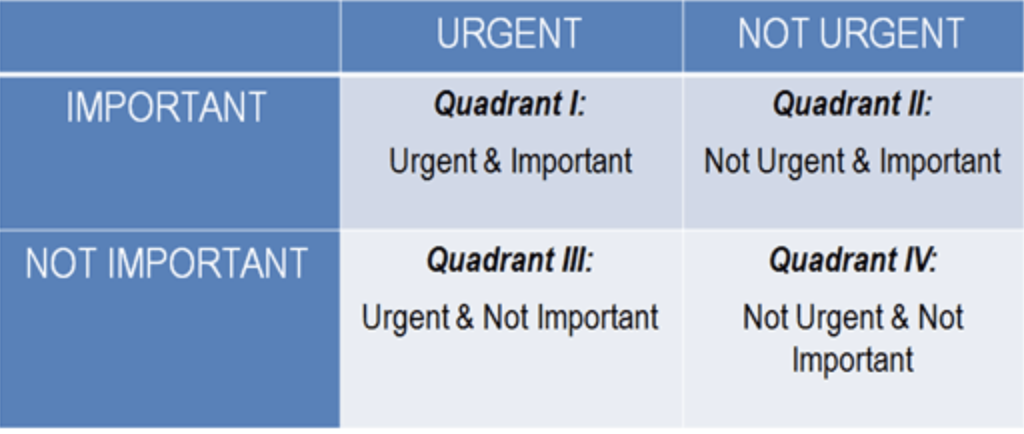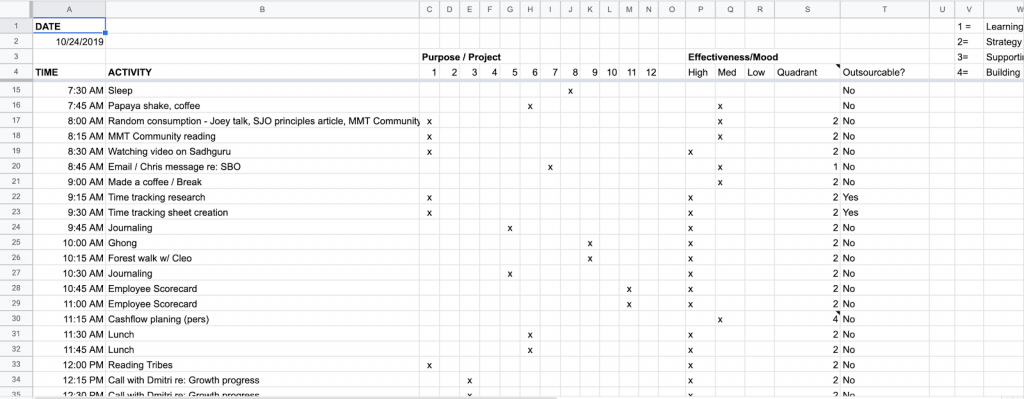- How to use the Eisenhower Matrix to prioritize your time.
- How to keep a time log in order to map to help with prioritizing your time.
- How to use these tools to define roles and delegate tasks.
“What is important is seldom urgent, and what is urgent is seldom important.”
These words are often attributed to Dwight D. Eisenhower, the 34th President of the United States and a five-star general who served as the Allied Forces Supreme Commander during World War II.
Eisenhower was renowned for his decision-making abilities, especially under pressure. And if there’s one thing that’s certain, an American President and wartime hero will face many difficult decisions in his lifetime.
Of course, determining which tasks to focus on each day can be its own source of stress. When the pile of dirty dishes starts to resemble the Leaning Tower of Pisa and the car is so dirty the grime looks like it was included in the purchase price; or when your email inbox is pushing into the tens of thousands, but the internet bill still needs to be paid – at times like this, it can be difficult to decide which task to prioritize first.
Richard Feenstra breaks down the concept well in this video:
For acquisition entrepreneurs who are on the hunt for a company, this is especially true. If you’re looking to acquire a business, life can seem especially crazy. Not only do you have all of your previous responsibilities to worry about, but you also need to worry about sourcing deals, due diligence, broker relations, and dealing with lawyers.
While Eisenhower never had to deal with the minutiae of Letters of Intent, he certainly had to prioritize his time. It was this that led Eisenhower to invent a process to help prioritize the tasks which deserved the most attention.
The Eisenhower Matrix
These days, people refer to this as the Eisenhower Matrix. The system has gained increased attention in recent years through Stephen Covey’s book, “The Seven Habits of Highly Effective People.”
Covey uses the matrix to break down the most effective ways to manage your time. With more people working from home than ever and all the distractions and disruptions that accompany that reality, time management has never been more important for people at all levels of an organization.
So, how we decide to prioritize issues is important. As described by Covey, the matrix is divided into four quadrants.

The First Quadrant is for the tasks that are both urgent and important and require immediate attention. The Second Quadrant consists of tasks that are not urgent but important. The Third Quadrant is for those tasks that require immediate attention but aren’t important; while the fourth Quadrant is for those that are neither urgent nor important.
Important tasks will help you achieve your goals. Urgent tasks are those that require immediate attention and are often linked to the accomplishment of someone else’s goals. Not addressing urgent issues will create immediate consequences.
Knowing Your Schedule
How you break down your time spent in Quadrant I or Quadrant II will depend on your position. However, regardless of what title you hold, your first step should be to track how you spend your time.
Keeping a time log can make you aware of whether or not you’re spending too much time on tasks that could be completed later.
Keeping a time log can make you aware of whether or not you’re spending too much time on tasks that could be completed later. Having to keep track of each minute of your day may sound like a nuisance, so that’s why I recommend doing it just two days out of each quarter. This should be enough to give you a good idea of where your efforts are best spent.
If you want to map your time, create two copies of a blank grid, one for each day. In the grids, list the tasks you accomplished or the activities you did and how much time each took. When all of the grids are full, combine the data and calculate how much you spent in each grid. You can then turn those numbers into percentages to effectively evaluate how you spent your time.
Here’s an example of a time log I made a couple of years ago. You can check it out here. If you’re interested in creating your own time log, we’ve made a blank document that you can see here.

The idea is to track your day in 15-minute increments. Then, ask yourself how each task makes you feel. That way you can understand if those chores strengthen you or weaken you.
I will also note whether or not these tasks can be outsourced. This helps you understand what tasks can be delegated in the future.
The Organization Structure
The problem with the first two quadrants is that most people tend to spend all of their time in Quadrant I and not enough time in Quadrant II. In his book, Covey says you should spend as much time in Quadrant II as possible.
He’s coming at this problem from a leadership perspective but I believe that how long you spend in Quadrant II depends on your position in the organization chart of your company.
I break down hours spent per week working on Quadrant II problems as follows:
| Technicians | Two hours |
| Managers | Four hours |
| Senior Managers | Six hours |
| Directors | Eight hours |
| Executives | Ten hours |
Technicians are usually found at the bottom of an organizational chart. That’s because they are the people who spend most of their day just completing tasks. They don’t spend much time managing, nor are they generally responsible for planning or strategizing.
The higher you climb in an organization, the more leverage your learning has. That’s because everything you learn and teach is multiplied by the number of cascading connections within the organization. So, if a CEO learns something while spending ten hours a week thinking about Quadrant II problems, they’re able to pass that knowledge down the line. It can be distributed through learning materials, videos, at meetings, and on a blog… But the knowledge is passed to the entire leadership team. The directors can then distribute it to the managers, who pass it on to the technicians.
What Is Quadrant II Behavior?
According to Covey, this quadrant is ideal for long-term strategizing. Eisenhower referred to this as the planning quadrant.

For me, this quadrant is integral to your long-term goals. It includes things like networking to further existing relationships or make new ones. It can also include learning new information. So, reading books or listening to audiobooks is a good use of Quadrant II time. Watching funny cat videos on YouTube would not be a good use of Quadrant II time. Unless, of course, you’re some sort of eccentric cat trainer.
Quadrant II time might also be about spending time with your employees to build up the work culture. Or it may mean improving systems that aren’t yet failing (because, obviously, if a system is failing, that’s an urgent problem).
The best Quadrant II action for you will be based on your personal flywheel, which we discuss here.

By using this method, President Eisenhower was able to determine which tasks deserved the most attention at any given time. It allowed him to delegate when necessary, but even if you don’t have a staff of your own, the matrix can be useful in determining how you prioritize your time.
However, if you are lucky enough to have a solid team behind you, the Eisenhower Matrix is a great tool for determining what work can be done by whom.
If you’re using it to analyze your own work habits, you can take the information you glean from using the matrix to create a to-do list. Try assigning a number to each task on the list that corresponds to the quadrant where that task belongs. From there, you just need to scratch off the tasks as they are completed.
So, whether you’re a top executive or middle management, this matrix is a great tool for determining how to prioritize your time. Of course, how you use it should depend on your position within the organization. It’s also important to let anyone working underneath you feel empowered to use their time in the same manner, just as long as they’re spending an appropriate amount of time on each task.
Personal Applications
I also like to use the Eisenhower Matrix to help improve my personal life. This isn’t necessarily about efficiency but about finding ways to help improve the lives of those around me.

In my case, every Sunday, I rotate through five key personal roles that are important to me. Those can include father, husband, brother, son, and more. Whatever the role, I select five people who are close to me and brainstorm a Q2 task that could help benefit them.
The task can be something I do with them or something to help that person. I then add that to my calendar in the afternoons. I also like to choose one thing I can do to help the community outside of work.
This is a great way to better integrate your life and prioritize what’s important. It also helps to bank a few brownie points now and then.
Do you have any secrets to managing your own time? Let us know in the comments.
Acquira's Accelerator Program is designed to help you find and acquire a business in half the time and at half the cost as it would take you through traditional methods. One of the primary ways we accomplish this is through strict time management and creating priorities. To learn about how we can help you, schedule a call with us and someone will be in touch within 24 hours.
Key Takeaways
- Determine how you spend your time
- Prioritize tasks using the Eisenhower Matrix
- Organize your time depending on your position in the organization
Acquira specializes in seamless business succession and acquisition. We guide entrepreneurs in acquiring businesses and investing in their growth and success. Our focus is on creating a lasting, positive impact for owners, employees, and the community through each transition.



